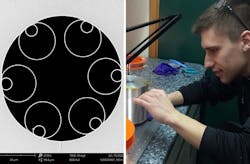Universities tout measurement of low back-reflection of hollow-core fibers
Researchers from the Optoelectronics Research Centre (ORC) at University of Southampton and the Centre for Optics, Photonics and Lasers (COPL) at Université Laval, Québec, say they have been able to measure the back-reflection of hollow-core fibers. The results, reported this month in The Optical Society’s journal Optica, indicate that the hollow-core fiber demonstrates back-reflection that is approximately 10,000X lower than conventional fiber.
As the name implies, hollow-core fiber carries light through a hollow core, rather than the silica core common to conventional fibers. The lack of a solid material reduces latency and non-linear effects, making it potentially attractive for a wide variety of applications (for example, watch the video “Advances in hollow-core fiber cable from OFS” or read “Startup Lumenisity unveils hollowcore fiber cables for DWDM applications, new funding” and "High-frequency traders using hollow core fiber: Wall Street Journal"). Such fibers also demonstrate low back-reflection; in fact, Nested Antiresonant Nodeless Fibres (NANFs) developed within the Southampton-led LightPipe research program, exhibit back-reflection too low to measure with conventional instruments.
Researchers at the ORC therefore turned to the measurement experts at COPL to address the problem. The result was the development of an instrument that was capable of providing reliable back-reflection measurements on the hollow-core fibers. Those measurements confirmed that the back-scattering within the Southampton-developed hollow-core fiber is better than four orders of magnitude lower than in standard fibers, which the researchers say was in line with theoretical expectations.
“The experimental confirmation of our theoretical prediction that back-scattering is 10,000X less in our latest hollow-core fibers than in standard all-glass fibers demonstrates their superiority for many fiber-optic applications,” stated Dr. Eric Numkam Fokoua of the ORC. “Moreover, the ability to measure such low back-scattered signal levels is also critical in the development of hollow-core fiber technology itself, in providing a critical route to distributed fault-finding in fabricated hollow-core fibers and cables as needed to drive forward improvements in their manufacturing processes. Existing technology is simply not sensitive enough to work with these radical new fibers and this work demonstrates a solution to this problem.”
For related articles, visit the Test and Measurement Topic Center.
For more information on test equipment and suppliers, visit the Lightwave Buyer’s Guide.
To stay abreast of optical communications technology, subscribe to Lightwave’s Enabling Technologies Newsletter.
Left: Light propagates through a central hole of the hollow-core fibre. Right: co-author Vincent Michaud-Belleau from COPL, Université Laval.
About the Author

Stephen Hardy
Editorial Director and Associate Publisher, Lightwave
Stephen Hardy is editorial director and associate publisher of Lightwave and Broadband Technology Report, part of the Lighting & Technology Group at Endeavor Business Media. Stephen is responsible for establishing and executing editorial strategy across the both brands’ websites, email newsletters, events, and other information products. He has covered the fiber-optics space for more than 20 years, and communications and technology for more than 35 years. During his tenure, Lightwave has received awards from Folio: and the American Society of Business Press Editors (ASBPE) for editorial excellence. Prior to joining Lightwave in 1997, Stephen worked for Telecommunications magazine and the Journal of Electronic Defense.
Stephen has moderated panels at numerous events, including the Optica Executive Forum, ECOC, and SCTE Cable-Tec Expo. He also is program director for the Lightwave Innovation Reviews and the Diamond Technology Reviews.
He has written numerous articles in all aspects of optical communications and fiber-optic networks, including fiber to the home (FTTH), PON, optical components, DWDM, fiber cables, packet optical transport, optical transceivers, lasers, fiber optic testing, and more.
You can connect with Stephen on LinkedIn as well as Twitter.
